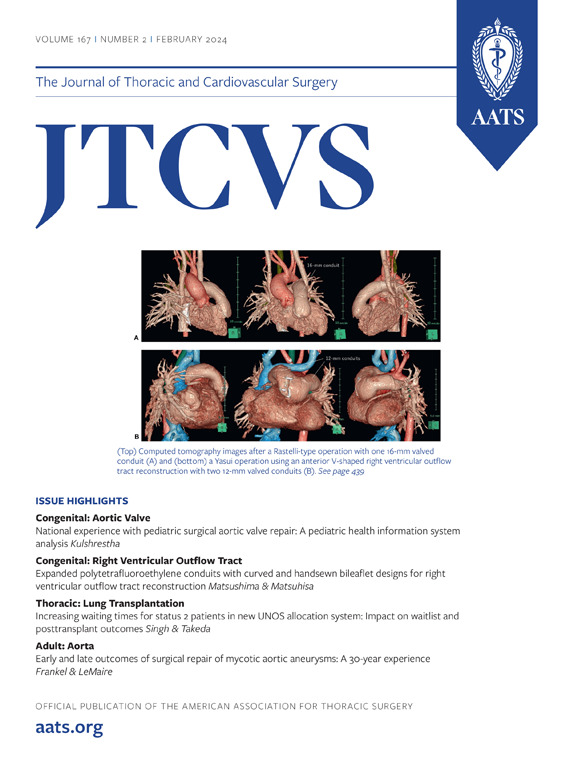早期非小细胞肺癌 (NSCLC) 的手术时间:确定从诊断到切除的最佳时间间隔以降低死亡率。
IF 4.9
1区 医学
Q1 CARDIAC & CARDIOVASCULAR SYSTEMS
Journal of Thoracic and Cardiovascular Surgery
Pub Date : 2024-12-16
DOI:10.1016/j.jtcvs.2024.11.040
引用次数: 0
摘要
目的:大多数影响癌症病例复杂性和预后的患者变量在术前是不可改变的。然而,从诊断到手术切除的时间是不稳定的。本回顾性研究旨在确定从非小细胞肺癌诊断到手术的最佳时间,以降低死亡率。方法:我们使用机构数据评估2009-2019年期间接受前期手术切除的成年早期非小细胞肺癌患者。诊断日期统一定义为提示诊断检查的计算机断层扫描(CT)日期。我们以2周为间隔评估手术时间。采用Cox回归分析并校正关键患者的社会人口统计学、临床和癌症特征,研究了手术时间与复发/新发肺癌的关系以及手术后1年和5年的总死亡率。结果:2567例早期患者中位手术时间为57.0 [IQR: 41.0-79.0]天。结论:尽管非小细胞肺癌侵袭性不同,但需要对手术时间的质量指标来优化结果。随着越来越多早期、可切除的非小细胞肺癌被发现,这一点将变得越来越重要。我们的研究结果表明,在基于ct的临床诊断后8周内进行手术可能是早期NSCLC患者的重要卫生系统目标。本文章由计算机程序翻译,如有差异,请以英文原文为准。
Time to surgery in early-stage non–small cell lung cancer: Defining the optimal diagnosis-to-resection interval to reduce mortality
Background
Most patient variables that impact cancer case complexity and outcomes are not modifiable preoperatively; however, the time from diagnosis to surgical resection is fluid. This retrospective study sought to identify the optimal interval from diagnosis of non–small cell lung cancer (NSCLC) to surgery to reduce mortality.
Methods
We evaluated adult patients with early-stage NSCLC who underwent upfront surgical resection between 2009 and 2019 using institutional data. The date of NSCLC diagnosis was defined uniformly as the date of a computed tomography (CT) scan that prompted a diagnostic workup. We evaluated the time to surgery in 2-week intervals. Using Cox regression analysis with adjustment for key patient sociodemographic, clinical, and cancer characteristics, we examined time to surgery associations with recurrent/new lung cancer and overall mortality at 1 and 5 years after surgery.
Results
Among 2567 early-stage NSCLC patients, the median time to surgery was 57.0 days (interquartile range, 41.0-79.0 days). Five-year mortality was elevated for surgeries performed at >8 weeks versus those performed at ≤8 weeks (adjusted hazard ratio [aHR], 1.19; 95% confidence interval [CI], 1.06-1.33) and at >12 weeks versus ≤12 weeks (aHR, 1.31; 95% CI, 1.10-1.55) after diagnosis. The rate of 1-year recurrence was also elevated for surgeries delayed for >8 weeks versus ≤8 weeks (aHR, 1.25; 95% CI, 0.98-1.60) and for >12 weeks versus ≤12 weeks (aHR, 1.62; 95% CI, 1.12-2.36).
Conclusions
Although NSCLC aggressiveness varies, quality metrics for time to surgery are needed to optimize outcomes. This will be increasingly important as more early-stage, resectable NSCLC cases are identified. Our results suggest that performing surgery within 8 weeks of CT-based clinical diagnosis may be an important health system target for early-stage NSCLC patients.
求助全文
通过发布文献求助,成功后即可免费获取论文全文。
去求助
来源期刊
CiteScore
11.20
自引率
10.00%
发文量
1079
审稿时长
68 days
期刊介绍:
The Journal of Thoracic and Cardiovascular Surgery presents original, peer-reviewed articles on diseases of the heart, great vessels, lungs and thorax with emphasis on surgical interventions. An official publication of The American Association for Thoracic Surgery and The Western Thoracic Surgical Association, the Journal focuses on techniques and developments in acquired cardiac surgery, congenital cardiac repair, thoracic procedures, heart and lung transplantation, mechanical circulatory support and other procedures.

 求助内容:
求助内容: 应助结果提醒方式:
应助结果提醒方式:


